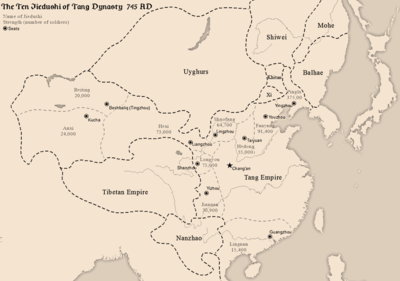This article is missing information about Song, Liao, Jin dynasties. cf. s:zh:宋史/卷171. (January 2021) |
| Jiedushi | |||||||||||||||||||
|---|---|---|---|---|---|---|---|---|---|---|---|---|---|---|---|---|---|---|---|
 Map of the 10 major jiedushi of the Tang dynasty and their military strengths during Emperor Xuanzong's reign (as of 745 AD) | |||||||||||||||||||
| Traditional Chinese | 節度使 | ||||||||||||||||||
| Simplified Chinese | 节度使 | ||||||||||||||||||
| Literal meaning | "section planning representative(s)" | ||||||||||||||||||
| |||||||||||||||||||
The jiedushi (Chinese: 節度使; Korean: 절도사; romaja: Jeoldosa; Vietnamese: Tiết độ sứ, Old Turkic: Tarduş) or jiedu, was a regional military governor in China; the title was established in the Tang dynasty and abolished in the Yuan dynasty. The post of jiedushi has been translated as "military commissioner", "legate", or "regional commander". Originally introduced in 711 to counter external threats, the jiedushi were posts authorized with the supervision of a defense command often encompassing several prefectures, the ability to maintain their own armies, collect taxes and promote and appoint subordinates.[1]
Powerful jiedushi eventually became fanzhen rulers (de facto warlords) and overrode the power of the central government of Tang. An early example of this was An Lushan, who was appointed jiedushi of three regions, which he used to start the An Lushan Rebellion that abruptly ended the golden age of the Tang dynasty. Even after the difficult suppression of that rebellion, some jiedushi such as the Three Fanzhen of Hebei were allowed to retain their powers due to the weakened state of the court. The jiedushi were one of the primary factors which contributed to the political division of the Five Dynasties and Ten Kingdoms period, a period marked by continuous infighting among rival kingdoms, dynasties, and regional regimes established by jiedushi.[citation needed]
- ^ "Middle Ranking Official of the Tang dynasty (唐代中層文官)" (PDF). Archived from the original (PDF) on March 10, 2012. Retrieved November 26, 2010.